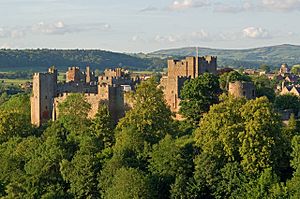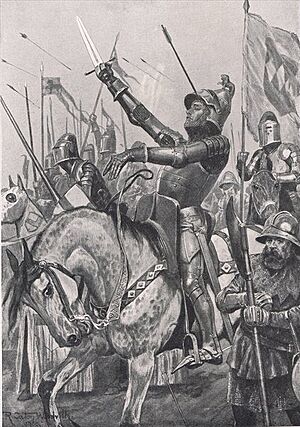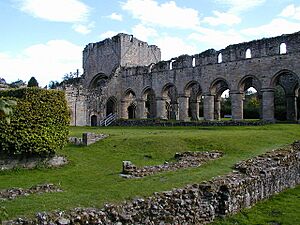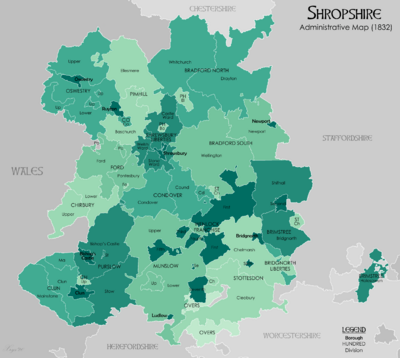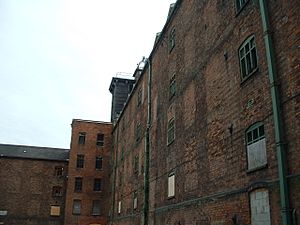History of Shropshire facts for kids
Shropshire is a county in England with a rich history, first mentioned in 1006. It was formed when the Saxon kingdom of Mercia was divided into shires. After the Normans conquered England in 1066, important Norman leaders like Roger De Montgomery were given land here.
The area of Coalbrookdale in Shropshire is known as the "birthplace of the Industrial Revolution." This is because many important new technologies were developed there.
Contents
- What's in a Name? The Story of Shropshire
- Shropshire's Borders: How They Changed
- Ancient Shropshire: From Tribes to Romans
- Shropshire Joins Mercia: Before 1066
- Shropshire After the Norman Conquest (1066 to Late Middle Ages)
- Shropshire in the English Civil War
- Shropshire's Economy: From Farms to Factories
What's in a Name? The Story of Shropshire
The name "Shropshire" comes from an Old English name, "Scrobbesbyrigscīr." This name literally means "Shrewsburyshire." It might have been named after Richard Scrob, who built Richard's Castle near Ludlow.
However, the Normans, who ruled England after 1066, found "Scrobbesbyrig" hard to say. They changed it to "Salopesberia" and "Salopescira." The shorter name, Salop, became a common way to refer to the county.
When a local government council was set up for the county in 1888, it was called "Salop County Council." Many people didn't like this name. In 1972, a Member of Parliament tried to change it back to "Shropshire." At first, the council didn't agree. But later, in 1980, they officially changed the county's name to Shropshire. This change happened on April 1, 1980.
Even today, people from Shropshire are sometimes called "Salopian." The Latin phrase Floreat Salopia, meaning "may Shropshire flourish," is also used as a motto for the county.
Shropshire's Borders: How They Changed
Shropshire shares a border with Wales. This border was set in the 1500s. Before that, some areas like Oswestry and Wem were part of Welsh borderlands.
Today, Shropshire's official boundary is very similar to its historical one. Some small areas that were separate from the main county (called "exclaves") or surrounded by it (called "enclaves") were moved to other counties. For example, Halesowen, a large exclave, became part of Worcestershire.
Over the centuries, Shropshire's border has changed slightly with all its English neighbours. It gained some land near Ludlow and Market Drayton. It also lost small pieces of land near Tenbury Wells and Leintwardine.
Ancient Shropshire: From Tribes to Romans
Who Were the Cornovii Tribe?
The entire area of modern Shropshire was once home to a Celtic tribe called the Cornovii. Their main settlement was a hill fort on the Wrekin hill.
Life Under Roman Rule
The Roman Empire expanded into this area around 47 AD. The Romans then reorganized the tribe's land. They moved the capital to a new Roman city called Viroconium.
Pengwern and the Kingdom of Powys
After the Roman rule ended, the Cornovii's land might have become part of the Welsh Kingdom of Powys. However, we don't know for sure. Some historians from the 1100s thought that Pengwern, an important Welsh place, was located near Shrewsbury.
Shropshire Joins Mercia: Before 1066
The Saxon Kingdom of Mercia
The northern part of Shropshire was part of the Wreocensæte territory. The southern part likely belonged to the Magonsaete. Both of these areas were taken over by the Saxon Kingdom of Mercia. King Offa of Mercia built Watt's Dyke in 765 to protect his land from the Welsh. In 779, he pushed further west, driving the Welsh King of Powys from Shrewsbury. He then built another defensive wall, Offa's Dyke, to secure his new lands. This dyke still forms part of Shropshire's border in some places.
Viking Attacks
In the 800s and 900s, Vikings often attacked this area. In 874, they destroyed the famous Wenlock Priory. In 896, they spent the winter at Quatford. To defend against these invaders, Æthelfleda, the Lady of Mercia, built forts at Bridgnorth in 912 and Chirbury in 913.
How Shropshire Was Formed
Mercia was divided into shires in the 900s after it recovered from the Vikings. The name "Shropshire" first appears in historical records in 1006. In 1016, Edmund Ætheling attacked and looted Shrewsbury.
Before the Norman Conquest, in 1053, the Welsh killed many English guards at Westbury. As a result, King Harold ordered that any Welshman found on the English side of Offa's Dyke should have his right hand cut off.
Shropshire After the Norman Conquest (1066 to Late Middle Ages)
The Norman Takeover
After the Norman Conquest in 1066, most of the important lands in Shropshire were given to Norman lords. The most important was Roger de Montgomerie, who became the first Earl of Shrewsbury. His son, Robert de Bellesme, lost his lands for rebelling against King Henry I.
Important landowners at this time included the Bishops of Chester and Hereford, and powerful Norman families like Ralph de Mortimer and Roger de Laci. The Fitz-Alan family, who were ancestors of the royal Stuart family, had great power in the Oswestry area.
Building Castles for Defense
The Norman lords in Shropshire had to constantly defend their lands from the Welsh. This led to a lot of castle building. Out of 186 castles in England, 32 were in Shropshire! This made Shropshire a very important area along the Welsh border.
Famous castles built during this time include Ludlow Castle, Bishop's Castle, Clun Castle, and Shrewsbury Castle. These castles were strongholds used to control the land and protect against attacks.
Shropshire's Forests
In this period, a large part of Shropshire was covered by forests. The biggest was Morfe Forest, which was a favorite hunting ground for English Kings. Other large forests included Wrekin and Stiperstones.
Protecting the Welsh Border
Shropshire's early history was often about fighting with the Welsh from across the border. Laws were put in place in the 1300s and 1400s to control the Welsh. For example, in 1379, Welshmen were not allowed to buy land in Shropshire unless certain conditions were met.
Shropshire in National Events
The powerful lords of Shropshire also played a role in bigger national conflicts. Shrewsbury Castle was held by supporters of Empress Maud in 1138 but was captured by King Stephen.
A famous law, the Statute of Acton Burnell, was passed at Acton Burnell Castle in 1283. In 1398, a parliament meeting was held in Shrewsbury.
One of the most famous events was the Battle of Shrewsbury in 1403. This battle was fought between King Henry IV and Henry Percy, also known as 'Harry Hotspur.' The King won the battle, which took place just north of Shrewsbury town. A chapel was built there to remember those who died.
Religious Buildings
Many important religious buildings were founded by the Normans in Shropshire. These included:
- Wenlock Priory, a monastery re-established in 1080.
- Haughmond Abbey, an Augustinian monastery.
- Buildwas Abbey, a Cistercian monastery founded in 1135, now a beautiful ruin.
- Shrewsbury Abbey, a Benedictine monastery founded in 1083.
- Lilleshall Abbey and Wombridge Priory, both Augustinian.
How Shropshire Was Divided: Hundreds
In England, "hundreds" were areas used for local government, justice, and taxes. Their importance slowly decreased over time.
The Domesday Survey, a great record from 1086, mentioned fifteen hundreds in Shropshire. These were completely reorganized in the 1100s, especially during the reign of King Henry I. Only a few, like Overs and Condover, kept their original names. Many old hundreds were combined or changed to form new ones. For example, the large hundred of Bradford was created from several older areas.
Although they are no longer used for administration, the concept of hundreds helped organize the county for many centuries.
Shropshire in the English Civil War
When the English Civil War began in the 1600s, most of the wealthy people in Shropshire supported King Charles I. The King visited Shrewsbury in 1642 and received money and valuable items from the people. Shrewsbury became a safe place for royalist supporters.
However, Wem was the first place in Shropshire to support Parliament. It was fortified in 1643. Shrewsbury was forced to surrender to Parliament's forces in 1645. Royalist strongholds like Ludlow and Bridgnorth were captured in 1646.
Shropshire's Economy: From Farms to Factories
Early Industries
Shropshire's first industries used its natural resources. The rivers provided fish, and the large forests gave plenty of timber. Minerals were also used from very early times. The Domesday Survey mentions salt-works. Lead mines were worked by the Romans, and coal was dug in the Clee Hills as early as 1260. Iron was also mined in the 1500s.
As forests were cleared for farming, Shropshire became more focused on agriculture. In 1343, Shropshire wool was very valuable. The county also had a successful clothing trade in Shrewsbury and Bridgnorth. Oswestry was known for its "Welsh cottons," which were cheap woolen cloths.
The Birthplace of the Industrial Revolution
Shropshire is sometimes called the "geological capital" of the UK. This is because almost every type of rock found in Northern Europe is present here. It also has rich deposits of coal, lead, copper, and iron ore. The River Severn flows through the county, which was important for transporting goods.
Because of these resources, the Ironbridge Gorge became a key area for new industries in the 1700s. Coalbrookdale, a small part of the Gorge, is considered the birthplace of the Industrial Revolution. This is where Abraham Darby I developed new ways to smelt iron using coke in the early 1700s.
The towns of Broseley and Madeley were centers of new ideas in the late 1700s. In Broseley, John Wilkinson made very accurate cylinders for steam engines. He also built the first iron boat in 1787.
Other important events of the Industrial Revolution happened nearby:
- Modern iron smelting was developed in Coalbrookdale.
- The world's first iron bridge was built in Ironbridge in 1779. This bridge connected Broseley with Madeley.
- The world's first iron-framed building, the Ditherington Flaxmill, was built in Shrewsbury.
Other places like Jackfield were known for tiles, and Coalport for china. Later, Broseley and Madeley became famous for making bricks and tiles, which were important for the growing building industry. Millions of Broseley clay pipes were also sent all over the British Empire.


